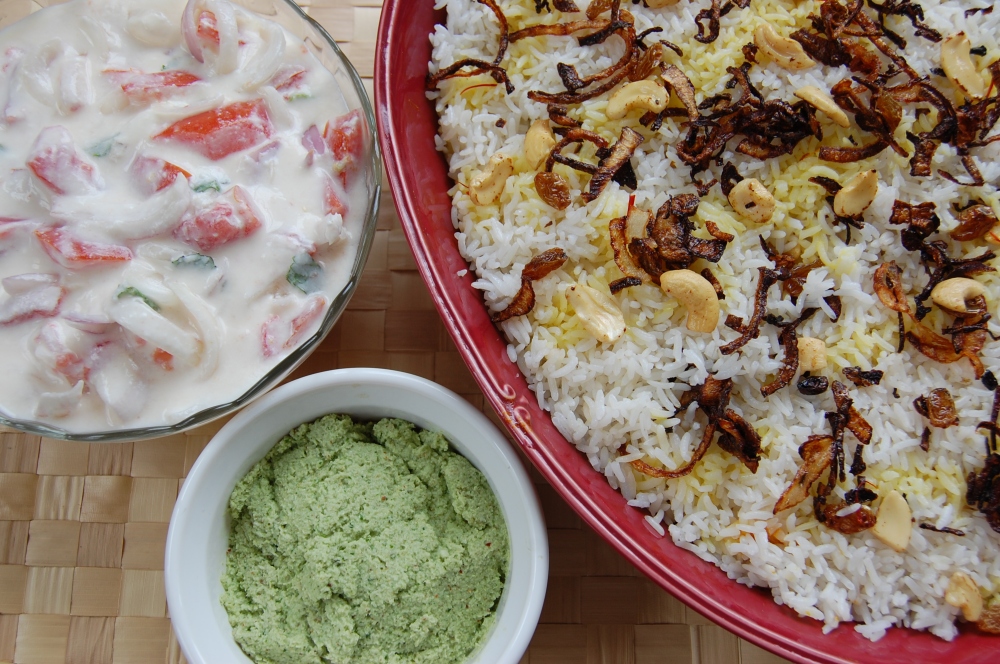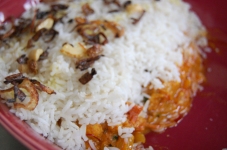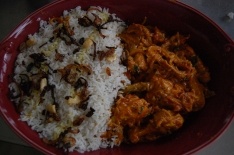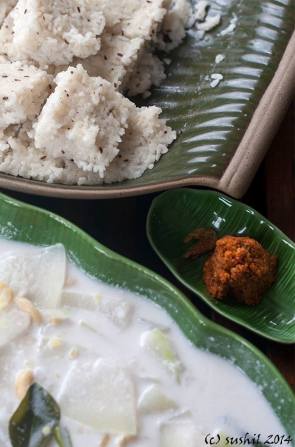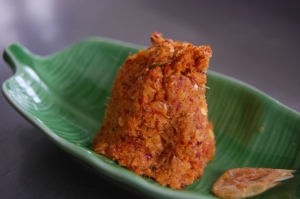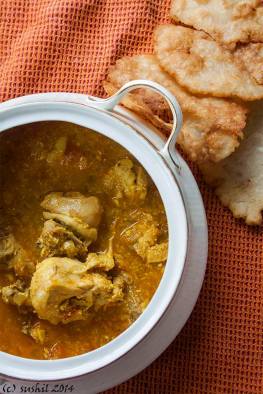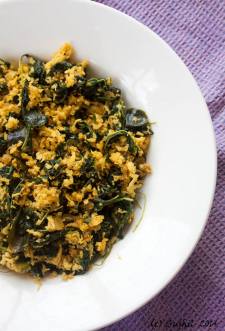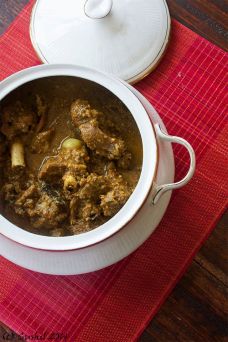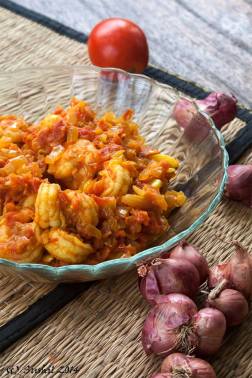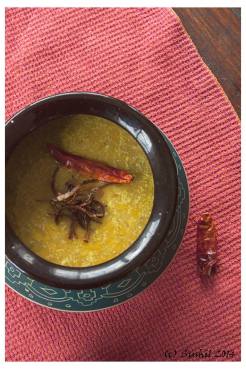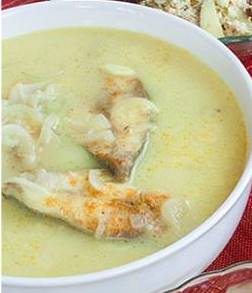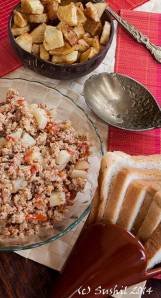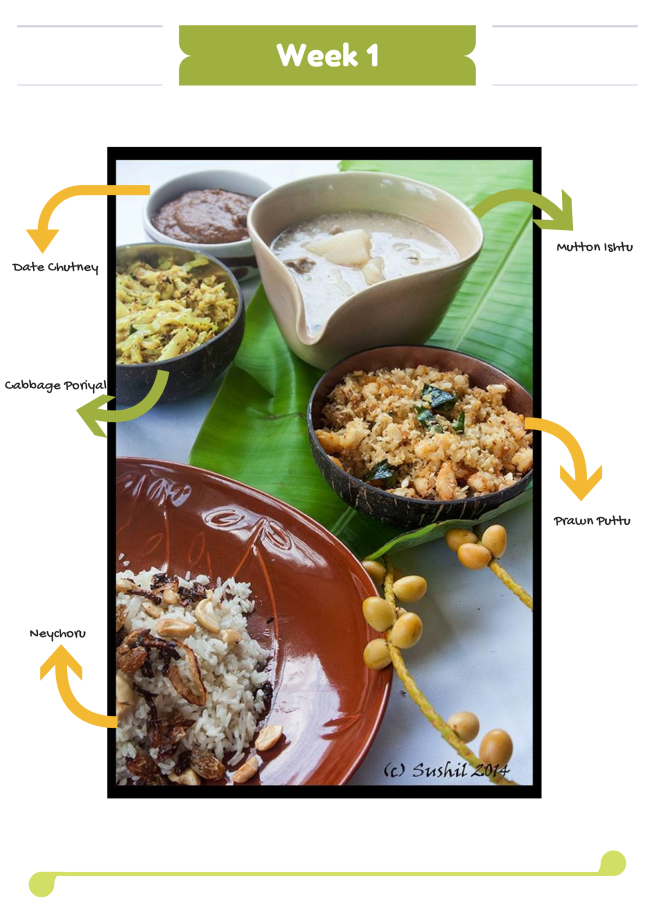My first ever attempt with no previous trials. It was more of a last minute decision.
I collected 2-3 recipes, retained the common factors and chose the rest. So, really I shouldn’t call it a Malabari Biryani; however, the essence of it is Malabari, i.e. the way it’s served and the ingredients in the masala.
After presenting it, one of the chefs told me what I did wrong and how it is prepared originally.
Here’s a little history on Biryani, especially of the Malabar kind.
Biryani travelled by land all the way from Persia to India. It’s one dish that Kerala did not receive from sea-faring visitors. Also, it was highly appreciated as it was a way to serve a complete meal in one container. Rice, meat, vegetables all in one pot. This was handy for those working in the fields.
Traditional Malabar Biryani is cooked on firewood and all the elements are made separately, coming together only in the end. The rice is cooked with whole spices such as cinnamon, cardamom and cloves. The meat (either chicken, fish or mutton) on the other hand is cooked in a spicy tomato and onion gravy rich in oil. The oil that floats to the top of the gravy is collected and poured over the rice just before serving. This flavoured oil makes the rice moist and ties it in with the meat. Of course, no Malabari meal would be complete without fried onions, cashews and raisins!
What makes Malabari Biryani different from other Biryanis is the fact that short grained rice is used. Unlike the usual Basmati rice, rice varieties like Jeerakasala and Jeerakachamba are used simply because of its abundance in the region. Also, the Biryani is served as a layered dish rather than its mixed counterparts. I used Saffron while cooking my Biryani, however, I learned later that it isn’t used traditionally.
Another interesting thing I found was that this Biryani is had with a Coconut Mint Chutney. I had never heard of a Biryani with chutney before.
1. Malabari/ Thalassery Biryani
For the rice:
Jeerakasala Rice/ Jeera Rice – 500g
Cinnamon – 1 small piece
Cardamom – 3 pods
Cloves – 5 cloves
Dry Bay leaf – 1 large leaf or 2 small leaves
For the masala:
Chicken (cut into small pieces with bones) – 500g
Onions(thinly sliced) – 150g
Tomatoes(thinly sliced) – 150g
Ginger Paste – 10g
Garlic Paste – 10g
Green Chillies (slit lengthwise) – 3-4
Juice of 1 lime
Curd – 300ml
Garam Masala powder – 5g
Turmeric powder – 10g
Red Chilli powder – 10g
Black Pepper powder – 5g
Coriander powder – 10g
Mace – 5g
Caraway seeds – 5g
Coriander leaves – a small bunch
Mint leaves – a small bunch
Salt to taste
For the garnish:
Onions(thinly sliced) – 150g
Cashew nuts – 20g
Raisins – 20g
Ghee/ Clarified Butter – 50g
Coconut Oil – 50ml
Method:
- Wash the rice and soak in water for 30 minutes.
- Drain the water completely and spread out the rice on a flat surface. Allow to dry.
For the garnish: - In a frying pan heat some of the ghee and oil.
- Once hot, toss in the sliced onions for the garnish.
- Fry until golden brown and crisp.
- Remove when crisp and leave to drain on a paper towel.
- In the same oil, fry the cashews and raisins until golden brown. (The raisins will swell slightly).
- Remove from heat.
For the rice: - Transfer this oil to a large pot. Add a little more ghee and oil.
- In another pot, boil water equal to twice the amount of rice. In this case, 1000ml.
- In the pot with the oil, fry the cinnamon, cloves, cardamom and bay leaves.
- To this, add the dried rice.
- Fry until you hear a crackling sound.
- Once this sound is heard, pour in the boiling water.
- Add salt (about 5g)
- Allow to cook till the rice is nearly done and most of the water has evaporated.
For the masala: - Prepare the chicken by washing it well.
- Marinate the chicken in the curd, salt, chilli powder, turmeric and some of the coriander powder
- In a kadai or a wok, heat oil.
- Fry onions, garlic paste, ginger paste and green chillies
- When the onions are softened and translucent, add in the tomatoes.
- To this, add the garam masala powder, coriander powder, turmeric, chilli powder, black pepper, mace, caraway seeds.
- Fry well until the raw smell of the spices goes.
- Then add in the chicken along with the marinade.
- Fry well.
- When the chicken is half cooked, add the juice of the lime and season with salt.
- Cook until the chicken cooks through and a layer of oil forms at the top.
- Collect the oil off the top and store it separately.
- Once the liquid has reduced to a thick paste, add in the chopped mint and coriander. Cook for another minute and turn off the flame.
To assemble:
- Lay out all of the meat gravy on the bottom of the dish.
- Spread the rice over the meat.
- Garnish with fried onions, cashews and raisins.
- Drizzle the oil collected from the gravy over the rice.
This is what it looked like half way through:
2. Thenga Chammandi
Freshly grated coconut – 50g
Mint leaves – a small bunch (25g)
Coriander leaves – 5g
Ginger – 1 small piece
Garlic – 2 cloves
Juice of half a lime
Method:
- Grate coconut
- Wash and remove stalks of mint and coriander
- Peel the ginger ad roughly chop it
- Combine all ingredients together and blend with a splash of water.
- It should form a thick paste.
3. Raita:
Curd/Yoghurt – 500ml
Onions – 150g
Tomatoes – 150g
Mint leaves – a small bunch
Salt to taste
Method:
- Roughly chop the onions.
- Roughly chop the tomatoes and remove the seeds.
- Clean and pluck the leaves of the mint.
- Combine all the ingredients with the curd.
- Season with salt.
- Mix well.


